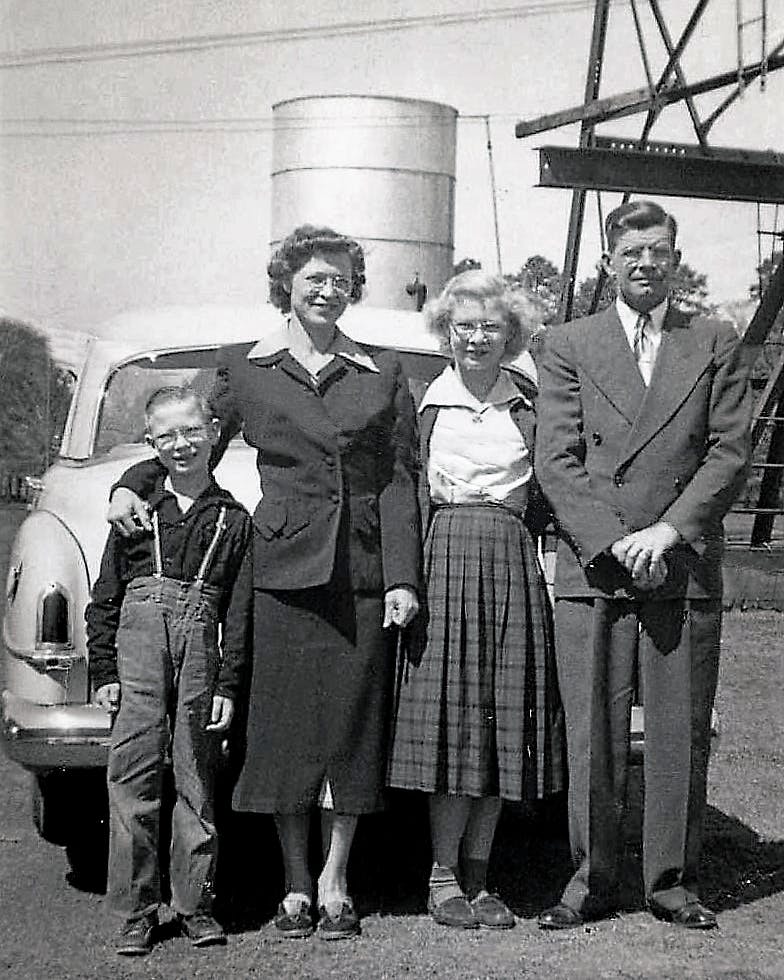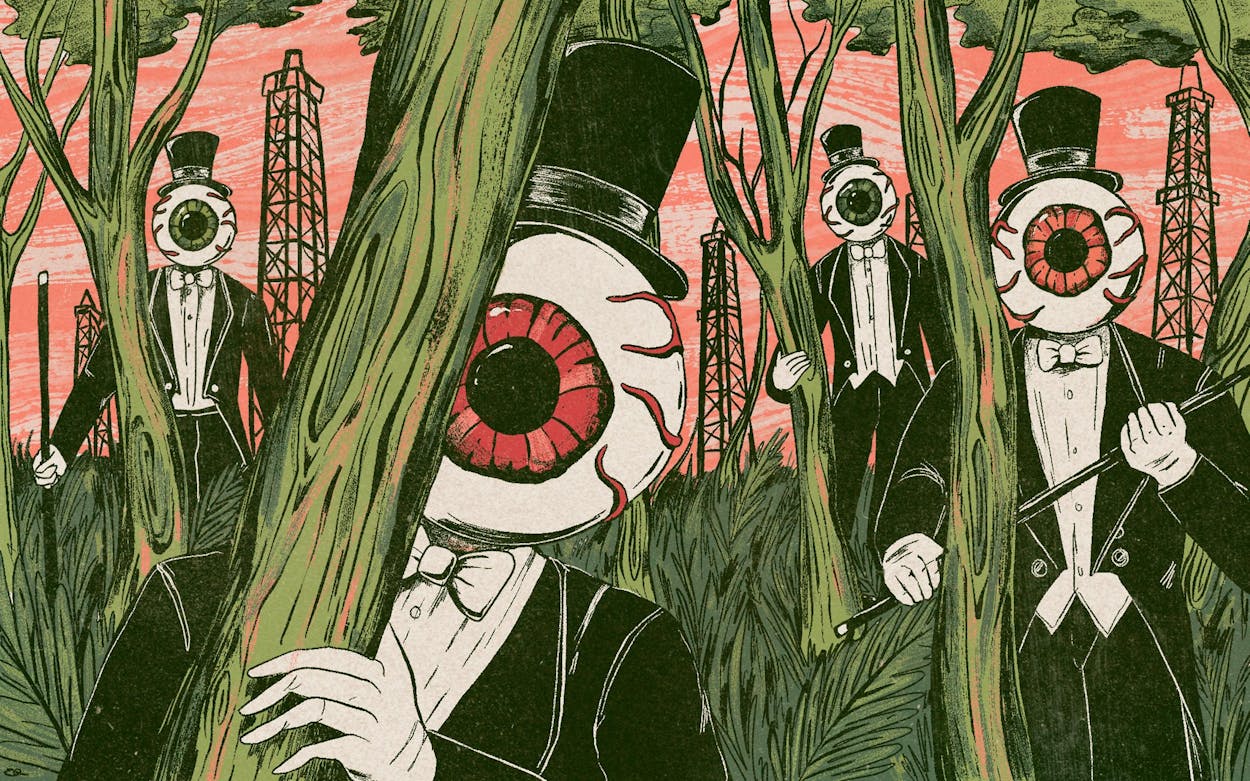As far as band photos go, there are few as iconic and surreal. Standing in front of the Golden Gate Bridge, the four members of the Residents look resplendent in their white-tie formal attire, their coattails flapping in the misty bay breeze, and their black top hats perched on the group’s most striking feature: four giant bloodshot eyeballs that serve as their heads. They resemble well-meaning alien emissaries, unaware of how freaky they look to human beings.
In American music—far from the upper echelons of Top 40 charts, your radio dial, and Spotify “trending” playlists—there is a vibrant legacy of weirdo artists who crafted their own vision of music, unrestrained by metrics such as audience, sales, or acceptance. Among them are some of the most colorful figures of the twentieth century: the itinerant hobo-turned-instrument-builder Harry Partch, the trout-mask-wearing blues deconstructor Captain Beefheart, and the composer, bandleader, and self-proclaimed Saturn denizen Sun Ra.
And then there’s the Residents. The group emerged from the San Francisco Bay Area in the early seventies and for the next fifty years would produce some of the era’s most baffling, bizarre, and, at times, irritating music. Les Claypool, of the band Primus, recalls his first encounter with the group’s sound in the 2015 documentary Theory of Obscurity: A Film About the Residents. “I absolutely hated it. To me, it was the music that they are probably playing in hell.” But soon he found himself in love. “Like a fungus, it kinda takes over.”
The Residents’ diverse fans and devotees have included Devo, Ween, and San Antonio’s Butthole Surfers. The band’s skeptical take on pop music informed radio disc jockey Dr. Demento’s syndicated odd-music program and influenced the likes of “Weird Al” Yankovic. In addition to the Residents’ more than thirty albums, there are groundbreaking music videos and multimedia performances that almost certainly influenced more-popular acts, such as Blue Man Group. The group’s peculiar sense of humor even infiltrated mainstream comedy: Simpsons creator Matt Groening was a charter member of the Residents fan club, and comedians such as Penn Jillette and Eric André are also ardent fans.
The group’s utterly strange music became an early staple of MTV, but despite that enviable exposure, the members of the band have remained shrouded in mystery. As MTV News anchor Kurt Loder once said, the group was “never photographed without some strange costume, never interviewed, never identified in any way. So who are these people?”
For the most part, no one outside their small circle really knew. Those giant eyeballs—or various other masks—rarely came off. In its early days, the group created its own label, Ralph Records, and a parent entity called the Cryptic Corporation, which employed four men—Hardy Fox, Jay Clem, Homer Flynn, and John Kennedy—who spoke on behalf of the group. Fox, perhaps explaining the Residents’ penchant for anonymity, once summarized the group’s prime function: “You make something cool ’cause that’s all that matters, that it turns out cool.”
Less than a year before his death from glioblastoma in 2018, Fox acknowledged in an email newsletter to fans what many had long suspected: that he was the Residents’ founder, producer, and main composer and arranger. (It is widely believed that Clem, Flynn, and Kennedy are the other original band members.) Which means that the origins of one of the strangest bands in semipopular music lie in the oil fields of East Texas.

Hardy Winfred Fox Jr. was born in Longview, forty miles east of Tyler, on March 29, 1945, to Hardy Winfred Fox Sr. and Lillian Idell Fox. “My mother was Methodist and my dad was Baptist, and they were both very, very religious: church every Sunday,” says Hardy’s younger sister, Diane Pasel. Hardy Sr. worked as a pumper in the oil fields and oversaw oil leases in the midst of the decades-long Texas oil boom; at one point, the East Texas oil field boasted more than 20,000 productive wells. Kilgore was at the center of that boom. One downtown block was known as “the world’s richest acre.”
The Foxes lived on an oil lease just outside Kilgore, some forty acres of land with five big oil wells on it. Hardy’s childhood friend Mason Terry recalls playing with him in a nearby dump and in one of the many slush ponds on the property: “There’d be scadzoos of tadpoles in it that we’d take to school and show off.”
Hardy Jr.’s older sister, Linda Perez, who lives in Cypress, remembers, “There’s some aspects of H. W. [a family nickname] that’s typical boy, but then he’s also kind of marching to the beat of his own drum.” When Hardy Jr. was three, “he had a windup record player and some children’s records,” she says, “and if nobody was looking, he would sing and dance to those with his own movements. But if somebody was looking, he wouldn’t do it.” He was always a creative sort, always on the hunt for funky-looking objects—lobster shells, bird feathers, strange rocks—to add to his collection.
Like most men of his generation, Hardy Sr. rarely showed emotion around his children. “There was something lost in the bonding, and my brother didn’t seem interested in anything that my father might want to do,” Perez says. Junior didn’t like sports, hunting, fishing, or much of the other standard fare for young boys in Texas. “His dad was a hard worker, and H. W. was a freewheeler,” his cousin Dave Clark recalls.
Hardy Jr. may have been named after his father, but he took after his mother. “She was a creative, poetic soul and, I think, understood him better than his father and his sisters,” says Steven Kloman, who was Hardy Jr.’s partner and spouse for the last 26 years of his life. “His sisters are very straightforward, analytical, and concrete. Linda has a [degree] in mathematics and worked for NASA. Diane was a pipe fitter.”
One summer, Hardy Jr. went to visit Clark in Texarkana for a week. Clark’s was a musical household (he would grow up to be a music teacher). His father often played ukulele or cued up easy listening hits of the era on the family record player, be it Lawrence Welk or the Italian conductor and composer Mantovani. He even had a magnetic tape recorder, newfangled technology at the time. “H. W. came up with this idea: ‘Let’s write a play, and the record player will be the background music,’ ” Clark recalls. “He wrote out the entire script, and we rehearsed it with the Mantovani. For emphasis and dramatic effect, H. W. would turn the volume up. After two days, we recorded it on that recorder. We listened back to it, and I thought, ‘Man, that sounds professional.’ I couldn’t believe he was doing this at fourteen.”
Cartoonist Gary Panter, who went on to collaborate with the Residents and win Emmys for set design on Pee-wee’s Playhouse, grew up in East Texas around the same time as Hardy Jr. He didn’t know him until later, but says, “Everyone in Texas [at the time would] mow their lawns religiously and go to some church, or else they [were] suspect. But Hardy seemed to have had the courage to think clearly for himself early on.” Whenever Hardy Jr. had to mow the lawn, his sisters say, he would cut his initials into the grass first before mowing the rest of it.
In 1961, when Hardy Jr. was turning sixteen, the Foxes left Texas and moved to Louisiana, first to Winnfield, then to Rayville, less than two hundred miles from Kilgore. Hardy Jr. was the new kid at Rayville High School, and while Perez remembers him as a shy loner—“almost the kind they caution people about”—he quickly showed off his creativity, erecting an entire town backdrop for the school talent show by sticking lamps under cardboard boxes he had painted.

Hardy Fox started as a freshman at Louisiana Tech University, in Ruston, in the fall of 1963. “He was an art major at an engineering school,” Louisiana native Homer Flynn says. The two became dorm mates and seemed opposites at first glance. Flynn was from an affluent family, and Fox was working-class. But the two quickly bonded over music. “We discovered we each possessed a different version of Ray Charles’s ‘What’d I Say,’ ” Flynn says. “He and I took our dueling versions, put them on two turntables, lined ’em up, and tried to make them play together. It upset someone in the dormitory, and we were reported to the dean.” It was an auspicious start to a lifetime of friendship and musical mischief.
While he was at college, the gap between Fox and his family widened. “It just seemed like he’d come home and want to argue with our parents,” Pasel says. “By the time he had to go back to the dorms, the whole house was in such turmoil.” His father wanted a sensible career for him, while Fox waded deeper into his art. One year, he dragged home a mural for the kitchen, “ten feet long and six feet tall of abstract art. Everyone was like, ‘What in the world is that?’ ” Pasel says. His mom loved it. Fox took five years to finish his degree; he finally landed on commercial art, graduating in 1968. He was drafted that same summer only to fail his physical because of “a mild form of epilepsy that he developed at college,” his sister recalls.
But Flynn remembers it differently. “One of the remarkable things about Hardy—and this could be a good thing and a bad thing—he had an amazing ability to create his own reality and buy into it,” he says. The draft was a case in point: Kennedy, who was also at Louisiana Tech at the time and would go on to become the Cryptic Corporation’s first president, suffered from terrible seizures, and Flynn believes that Fox convinced himself—and others—that he too was afflicted with petit mal seizures. “From a creative point of view, this ability to create his own reality was very empowering,” Flynn adds. “But it leads you off on an island by yourself because no one can figure out what you’re up to.”
Not long after that failed physical, Flynn, Fox, Kennedy, and Clem (who also attended Tech) escaped to the Bay Area. “The South is not always that nice of a place,” Fox explains in Theory of Obscurity. He was appalled by the racist backlash against the civil rights movement and wanted to live somewhere more conducive to his brand of off-kilter creativity. These Southern boys were hitting the West Coast during the hippie era, eventually landing in San Francisco’s Mission District. But they didn’t integrate into the scene as easily as they might have hoped. “Being from the South, you can’t totally relate to California and all that, so you sorta stick with your own people a little bit,” Fox once explained.
Far from his biological family, Fox instead created his own sense of community from a cadre of friends and like-minded eccentrics. Outside of annual visits, he rarely returned to the South. He ultimately seemed to find a sense of home out west; in his later years he would come out as gay and marry his partner.
The Residents’ earliest music first took shape on Fox’s two-track tape machine. He began a correspondence with Hal Halverstadt, a Warner Bros. Records executive responsible for signing fellow weirdo Captain Beefheart. A demo tape sent to him was returned, addressed to “Residents.” The name stuck. In the Residents’ hands, pop music warped as if in a fun-house mirror, mangled into something silly, unsettling, unrecognizable. “Music was dominated by people who could play, but it leaves an area of unexplored sound opportunities for people who can’t,” Fox explained in Theory of Obscurity. A naive primitivism runs through the Residents’ discography; at moments, the band’s music sounds like toddlers pounding on keyboards or jazz as rendered on a kazoo.
“Hardy sent a record home, and my mother played it for me and for my husband,” Perez recalls. “And I go, ‘Uh . . . what is that?’ because it was not like music I’d ever heard before. How can anyone listen to that? It almost hurts my ears!” (Pasel is more succinct: “I wasn’t a fan.”) Clark says that his cousin “tried to explain it to me once, but he was laughing the whole time, saying I wouldn’t understand it. But I was amazed by what he was doing.”
The group’s covers of the Rolling Stones’ “Satisfaction,” Hank Williams’s “Kaw-Liga,” and Nancy Sinatra’s “These Boots Are Made for Walkin’ ” sound as if they’re transmitted from a bizarro world where atonal noise and adenoidal growling are the earmarks of a hit. Album concepts could range from the imaginary music of Eskimos (including, at one point, a hilariously twisted faux field recording of a groaning walrus being dragged out of the water by hunters) to relatively straight-faced synthesized takes on the likes of George Gershwin and John Philip Sousa to 1976’s Third Reich ’n Roll, a collage of skewered hits that equates pop music with fascism, right down to the cover art depicting American Bandstand host Dick Clark in a Nazi SS uniform.
The group created a music video for one of that album’s tracks, a demented version of Wilson Pickett’s “Land of 1000 Dances,” retitled “Swastikas on Parade.” It’s a black-and-white film of stop-motion animation. Drill bit–fitted grocery carts, giant skulls, and pork chops dance as Fox and the band perform decked out in coned hats and newspaper gowns. It’s impossible to miss the resemblance to the white hoods and robes of the Ku Klux Klan.
“Hardy spoke about seeing Klan rallies at Little League baseball parks in Rayville,” Flynn says. “I remember him speaking of seeing crosses burned.” Hardy’s sisters are adamant that they never saw any Klan activity when they were growing up. But according to data from Virginia Commonwealth University, numerous branches of the KKK arose throughout the region beginning in 1926, with outposts established in Longview, in Winnfield, and near Rayville, the towns where they grew up.
Perhaps Fox saw something worth subverting in the Klan’s anonymity. Where the KKK’s infamous hoods provided its members the license to act out evil impulses, the Residents suggested that liberty could be put to much better uses. Those giant, face-obscuring eyeballs offered Fox and his collaborators the license to pursue their kookiest creative ideas down the rabbit hole, without fear of being mocked. That sense of freedom was, apparently, contagious. In a recently released coffee-table art book, The Residents: A Sight for Sore Eyes, Vol. 1 (Melodic Virtue), famous composers, comedians, and punk legends attest that no matter how weird and isolated they felt, they were at home in the Residents’ world.
Though the group still performs live (another advantage of anonymity: no one can tell whether the masked performers are members of the original troupe), Fox retired from touring with the Residents in 2015, three years before his death.
“Hardy was the architect of the Residents’ sound and the best friend I ever had,” Flynn says. “He had a great feeling for combining sounds in unique and compelling ways. He was one of a kind, for sure. But transparency was not one of his better characteristics. He kept a lot inside.” In that way, he ultimately reminds his sister Linda of his namesake: “Because the world that he lived in was so different from ours, he didn’t talk about his music. He talked very little about his life. He was a lot like our father in that regard.”
She pauses to consider the Residents and her late brother’s musical legacy, then adds: “I still don’t get it. I wish I could. I wish I understood.”
San Antonio native Andy Beta contributes to the New York Times and the Washington Post.
This article originally appeared in the February 2022 issue of Texas Monthly with the headline “The Man in the Eyeball Mask.” Subscribe today.







